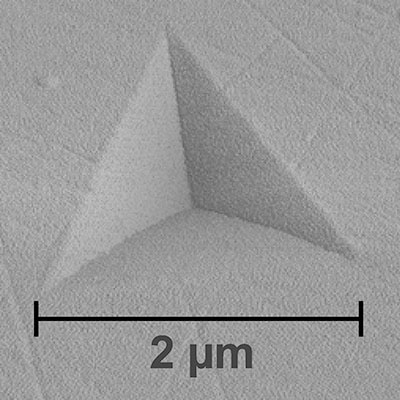Nanoindentation is one of the most important techniques for the quantitative characterization of mechanical properties of materials. Essentially it works by of pushing a hard, sharpened indenter tip with a well-defined shape against the surface of a sample. This tensile testing technique is used to precisely and locally characterize materials of all sorts (thin coatings, metals, ceramics, polymers, biomaterials etc.) at a nanoscale level, and can also be of great interest for heterogeneous surfaces (different phases, porous materials, depth sensing, defects vs. intact surface, etc.). By analyzing force-displacement curves, it is possible to extract sample hardness and elastic modulus without measuring the residual imprint as it is done with conventional macroscale hardness techniques.

As a challenge, the rule of thumb says that the depth of penetration should not exceed 10% of the coating’s thickness to avoid influences of the underlying substrate. For a 1-μm thin film, this corresponds to a maximum indent of 100 nm. Moreover, to avoid the influence of surface roughness on the measurement, it should be smaller than 20% of the indentation depth. For a roughness of 10 nm, the minimum depth of indentation should therefore be 50 nm.
AFM and Nanoindentation combined
Nanoindentation and atomic force microscopy (AFM) can be coupled in a single system with an accurate repositioning stage to allow a comprehensive and (semi)automated analysis. In a first step, the atomic force microscope measures surface roughness to help define the minimum indentation depth. Then the sample is precisely positioned under the nanoindenter to perform a mechanical analysis on the same location. In a last step, this location can again be moved under the AFM to characterize and understand stress-induced features such as material pile-up, sink-in, or cracks induced around the indentation. If observed, these effects might have an influence on the values obtained for hardness and elastic modulus.
In a publication by Perfler et al. (Inorg. Chem. 54 (2015) 683), the Nanosurf NaniteAFM was used together with a Micro Materials nanoindentation system to obtain the image shown above (courtesy of the authors). It shows the residual imprint of a nanoindenter without any of the above-mentioned stress-induced features.

